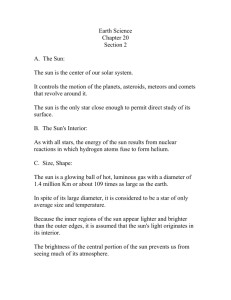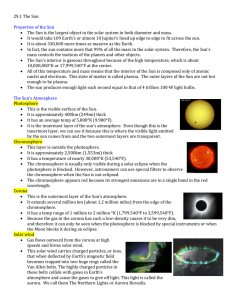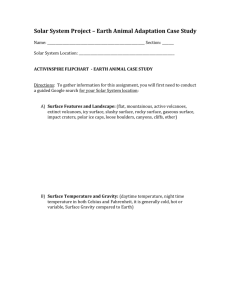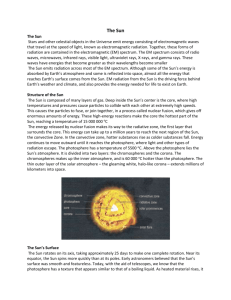TERRESTRIAL-SOLAR ENVIRONMENT AND EFFECTS ON MANNED SPACEFLIGHT Chapter 7
advertisement
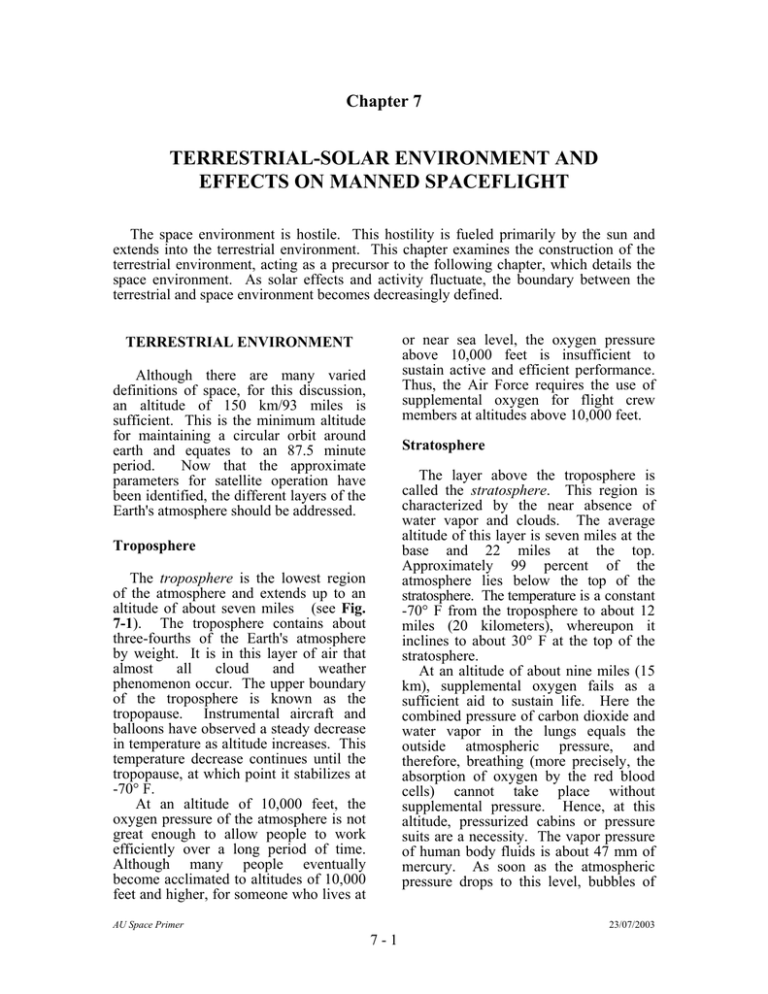
Chapter 7 TERRESTRIAL-SOLAR ENVIRONMENT AND EFFECTS ON MANNED SPACEFLIGHT The space environment is hostile. This hostility is fueled primarily by the sun and extends into the terrestrial environment. This chapter examines the construction of the terrestrial environment, acting as a precursor to the following chapter, which details the space environment. As solar effects and activity fluctuate, the boundary between the terrestrial and space environment becomes decreasingly defined. or near sea level, the oxygen pressure above 10,000 feet is insufficient to sustain active and efficient performance. Thus, the Air Force requires the use of supplemental oxygen for flight crew members at altitudes above 10,000 feet. TERRESTRIAL ENVIRONMENT Although there are many varied definitions of space, for this discussion, an altitude of 150 km/93 miles is sufficient. This is the minimum altitude for maintaining a circular orbit around earth and equates to an 87.5 minute period. Now that the approximate parameters for satellite operation have been identified, the different layers of the Earth's atmosphere should be addressed. Stratosphere The layer above the troposphere is called the stratosphere. This region is characterized by the near absence of water vapor and clouds. The average altitude of this layer is seven miles at the base and 22 miles at the top. Approximately 99 percent of the atmosphere lies below the top of the stratosphere. The temperature is a constant -70° F from the troposphere to about 12 miles (20 kilometers), whereupon it inclines to about 30° F at the top of the stratosphere. At an altitude of about nine miles (15 km), supplemental oxygen fails as a sufficient aid to sustain life. Here the combined pressure of carbon dioxide and water vapor in the lungs equals the outside atmospheric pressure, and therefore, breathing (more precisely, the absorption of oxygen by the red blood cells) cannot take place without supplemental pressure. Hence, at this altitude, pressurized cabins or pressure suits are a necessity. The vapor pressure of human body fluids is about 47 mm of mercury. As soon as the atmospheric pressure drops to this level, bubbles of Troposphere The troposphere is the lowest region of the atmosphere and extends up to an altitude of about seven miles (see Fig. 7-1). The troposphere contains about three-fourths of the Earth's atmosphere by weight. It is in this layer of air that almost all cloud and weather phenomenon occur. The upper boundary of the troposphere is known as the tropopause. Instrumental aircraft and balloons have observed a steady decrease in temperature as altitude increases. This temperature decrease continues until the tropopause, at which point it stabilizes at -70° F. At an altitude of 10,000 feet, the oxygen pressure of the atmosphere is not great enough to allow people to work efficiently over a long period of time. Although many people eventually become acclimated to altitudes of 10,000 feet and higher, for someone who lives at AU Space Primer 23/07/2003 7-1 water vapor and other gases (notably nitrogen) appear in the body fluids. This means the blood literally starts to boil as these bubbles continue to expand. The gas bubbles first appear on the mucus membranes of the mouth and eyes and later in the veins and arteries. This would happen to an unprotected person at an altitude of about 12 miles (20 km). Wearing a pressure suit or being contained in a pressurized cabin will prevent this problem. At 15 miles (25 km), compressing the outside air to pressurize a cabin is no longer feasible. The air density is about 1/27 of the sea level value at this altitude. Compressing this thin air is not an HARD-VACUUM MAGNETOSPHERE EXOSPHERE THERMOSPHERE 1000 MESOSPHERE 300 50 22 IONOSPHERE STRATOSPHERE TROPOSPHERE Fig. 7-1. Space Regions NOTE: All altitudes (given in miles) are approximate. Latitudes, seasons and solar activities cause significant deviations. AU Space Primer 7/24/2003 7-2 impossible task, but is certainly not an economical one. Furthermore, the process of air compression would involve undesirable heat transfer to the air. Finally, the atmosphere at this altitude contains a significant percentage of ozone, which if compressed, would poison the cabin atmosphere. Above 15 miles (25 km), the cabin or space suit must have a supply of both oxygen and pressure independent of the outside atmosphere, thus adding significantly to the weight and degree of sophistication of a vehicle. As far as a man is concerned, this altitude could be considered the beginning of space. Above this altitude, man must take everything he needs for survival, as this environment will supply him no food, water or air. The upper boundary of the stratosphere contains the greatest concentration of ozone, which is a vital part of the Earth's atmosphere. It absorbs a large part of the Sun's ultraviolet radiation, shielding the fragile process we call life from its harmful effects. This absorption process heats up the thin atmosphere at this altitude to a temperature of 30° F. (80 km). A pilot flying at or above this altitude earns astronaut wings. Thermosphere The thermosphere extends up to somewhere between 200-300 miles (320480 km) beginning at about 50 miles (81 km) (experts do not agree on an exact division). From the low temperature of -135° F at the top of the mesosphere, the temperature curve increases again, reaching as high as 2,200° F. The atoms and molecules in this layer are bombarded by powerful electromagnetic waves from the Sun and become charged or ionized, causing extreme temperatures. The thermosphere is also the region where the Aurora Borealis or the aurora occurs, although it has been observed as high as 1,000 km. The solar wind plays an important role in the aurora by either supplying the necessary charged particles or by perturbing the magnetosphere so that the particles are "dumped" into the atmosphere near the magnetic poles. As these particles collide with the sparse gas molecules in the upper atmosphere, light energy released causes auroral displays. In 1964, a New York law firm asked the Air Force Office of Aerospace Research to define the beginning of space. This scientific organization based their answer on aerodynamic forces, probably because the majority of the staff were associated with flying. These forces, acting on ballistic reentry vehicles, lifting reentry vehicles and boost-glide orbital vehicles, can usually be neglected at altitudes above 62 miles (100 km). Therefore, if an aeronautical engineer is concerned with lift and drag, space begins above this altitude. About 100 miles (161 km) above the Earth is a region of darkness and complete silence. This is called the Black Sky region. The stars appear as brilliant points of light and the area between them is jet black because there is not enough air to scatter or reflect the light rays. Mesosphere The region of the atmosphere called the mesosphere extends from the top of the stratosphere at 22 miles (35 km) to about 50 miles (80 km). All but onemillionth of the atmosphere lies below the top of the mesosphere, where the atmosphere is so thin that no sound can be transmitted. The operating limit for turbojet engines is reached at 26 miles. However, there is not enough oxygen in the atmosphere to operate even a ramjet engine once it reaches 28 miles. Engines must be supplied with both a fuel and an oxidizer above this altitude. Thus, to a propulsion engineer, space commences at 28 miles (45 km) because rockets must be used for propulsion above this height. On the administrative side, space starts at the top of the mesosphere at 50 miles AU Space Primer 7/24/2003 7-3 Also part of the thermosphere is the ionosphere. When we discuss communications, both ground and via satellite, the ionosphere plays a significant role in the success or failure of the communications. The ionosphere begins in the upper part of the mesosphere and extends upward through the thermosphere and ends just short of the exosphere in the upper region of the thermosphere. The Sun's rays, including X-rays and ultraviolet radiation, pass into the thermosphere and break the layer's molecules into positive ions and negative electrons. These ions and electrons refract radio transmissions from earth back toward the surface, facilitating the reception of long-range radio broadcast in the High Frequency (HF) frequency range. The ionosphere will be discussed in more detail in this publication's Chapter 6. extent, escape into outer space. There are so few molecules in this outer stretch of the atmosphere that even temperatures are hard to define. THE SOLAR ENVIRONMENT The Sun The Sun is a typical star - a great sphere of luminous gas (see Fig. 7-2). It is composed of the same chemical elements that compose the Earth and other objects of the universe, but in the Sun (and other similar stars) these elements are heated to a gaseous state. Tremendous pressure is produced by the great weight of the Sun's layers. The high temperature of its interior and the consequent thermonuclear reactions keep the Sun gaseous. These nuclear reactions are the source of the energy continuously radiated to space, which drives solar activity. A relatively small core contains most of the mass and is almost entirely responsible for the Sun's luminosity. The core is defined as the central sphere within one fourth the radius of the Sun. Exosphere The exosphere is the most distant atmospheric region from the Earth's surface. The upper boundary of the layer extends to heights of perhaps 960 to 1000 miles and is relatively undefined. The exosphere is a transitional zone between Earth's atmosphere and interplanetary space. It is only from the exosphere that atmospheric gases can, to any appreciable AU Space Primer The Sun's core temperature is 15 million degrees Kelvin (K). Its pressure is approximately 250 billion atmospheres and its specific gravity is slightly less than 160. The energy released in the core Fig. 7-2. The Sun 7-4 7/24/2003 results from the fusion of hydrogen nuclei to form helium nuclei. The core also contains almost all of the products or "ashes" of the nuclear burning. The next region out from the core is called the radiative envelope because the energy generated in the Sun's core is transferred toward the surface by radiation. Outward from the core, the temperature, pressure and density decrease rapidly, as does the energy of an average photon. Photons are absorbed and re-emitted many times as they diffuse toward the surface. In this way, the energy flowing from the core in the form of high-energy gamma rays is changed to x-rays, to extreme ultraviolet (EUV) rays, to ultraviolet (UV) rays and finally to the lower energy visible light which is most characteristic of the solar energy freely radiated to space. Temperature is the gas property that is primarily responsible for the establishment of a turbulent layer beneath the Sun's surface. In the radiation zone, the temperature has reached a value which is low relative to that in the core (1 million degrees K). The final layer of the solar interior is the convection envelope zone. As the name implies, the primary mode of energy transfer through this zone is direct transport, rather than radiation. Each element of rising gas carries its own parcel of energy directly to the surface. In addition to this mode of transfer, the powerful turbulence generates noise or "mechanical energy," which as lowfrequency sound waves, propagates through the photosphere and into the Sun's outer layers. Although the amount of energy transported in this way is relatively small, it plays a major role in establishing the character of the outer layers of the Sun. The only parts of the Sun that can be observed directly are its outer layers, collectively known as the Sun's atmosphere. The solar atmosphere is not stratified into physically distinct layers with sharp boundaries. Yet there are three general regions each having substantially different properties, gradually transitioning from one region to the next. These are the photosphere, the chromosphere and the corona. Photosphere The solar photosphere is what one sees when looking at the sun. It is not a discrete surface but instead covers a range of depths from which the solar radiation escapes. The energy radiated by the photosphere constitutes almost all of the energy emitted by the Sun. Direct telescopic observation and photography show that the photosphere is not perfectly smooth, but has a mottled appearance resembling rice grains. This structure of the photosphere is now generally called granulation. Typically, granules are about 1,000 km in diameter (the smallest observed are about 300 km across). They appear as bright spots surrounded by narrow darker regions. The granules themselves are columns of hotter gases rising from below the photosphere and as the rising gas reaches the photosphere it spreads out and sinks down again. The darker intergranular regions are the cooler gases sinking back, while the centers of the granules are hotter than the intergranular regions by 50 to 100 degrees K. The vertical motions of gases in the granules have speeds of about 2 or 3 km/s. Individual granules persist for about 8 minutes and are the pinnacles of convection currents of gases seen through the photosphere. The most conspicuous features of the photosphere are the Sunspots. Occasionally, spots on the sun are large enough to be visible to the naked eye and such spots have been observed for many centuries. Galileo was the first to show Sunspots to be on the surface of the sun, rather than opaque patches in the Earth's atmosphere or the silhouettes of planets between the sun and earth. In 1774, Alexander Wilson suggested the spots were "holes" through which one could see past the photosphere into a cooler interior of the sun. However, the spots are not holes in the photosphere, but AU Space Primer 7/24/2003 7-5 rather regions where the gases are cooler than those of the surrounding regions. Sunspots are still hotter than the surfaces of many stars and if they could be removed from the sun, they would be seen to shine brightly; they appear dark only by contrast with the hotter, brighter surrounding photosphere. Individual Sunspots have lifetimes that range from a few hours to a few months. Most of them disappear within a day but a few persist for a week or occasionally much longer. Filaments are the same phenomena, but are seen against the solar disk and consequently appear darker than the hotter solar background. The space environment is determined to a very large extent by the Sun. Many phenomena on or near the Earth are closely related to solar activity, although sometimes the exact nature of the relationship is not well understood. The Sun is constantly radiating energy even under quiet conditions. This "steadystate" phenomenon is called the solar wind. Because of the high temperature of the Sun's corona, protons and electrons beyond a certain distance from the Sun acquire velocities in excess of the escape velocity from the Sun. Thus, there is a continuous outward flow of charged particles in all directions from the Sun. This quiet is interrupted at irregular intervals by "transient" solar flares of varying intensity, which appear suddenly over small areas of the Sun. The high speed of solar protons emitted by a solar flare are probably the most potent of the radiation hazards to space flight. Flares themselves are probably the most spectacular disturbances seen on the Sun. They are observed optically as a sudden large increase in light from a portion of the Sun's atmosphere. A flare may spread in area during its lifetime, which may be from several minutes to a few hours. There is a relationship between the number of Sunspots and the frequency of flare formation, but the most important flares do not necessarily occur at solar cycle maximum. There are many events that may occur on Earth following a solar flare. In addition to the increase in visible light minutes after the start of a flare, there is a Sudden Ionospheric Disturbance (SID) in the Earth's ionosphere. This, in turn, causes short wave fadeout, resulting in the loss of long range communications for 15 minutes to an hour. X-rays emitted by the flare probably cause the SIDs. During the first few minutes of a flare, there may be a radio noise storm consisting of bursts of noise over a wide Chromosphere The region of the Sun's atmosphere immediately above the photosphere is the chromosphere. Until this century the chromosphere was best observed when the Moon, during a total solar eclipse covered the photosphere. Today it is possible to photograph both the chromosphere and its spectrum outside of an eclipse. The chromosphere is about 2,000 to 3,000 km thick, but in its upper region it breaks up into a forest of jets (called spicules). So the position of the upper boundary of the chromosphere is somewhat arbitrary. The temperature increases through the chromosphere from 4,500° K at the photosphere to 100,000° K or so at the upper chromospheric levels. Ultraviolet observations of the chromosphere, such as those made from Skylab, have been especially helpful in revealing information about its structures. Corona The final layer of the solar atmosphere is the corona, which extends from the top of the chromosphere out millions of miles into space. The corona is normally invisible except during an eclipse or when using a coronagraph. The average temperature of the corona is 1.5 million degrees K. The corona exists in a fully ionized state, within which ionized gas occasionally condenses and streams down the localized magnetic field lines. As seen against the background of space, these are called prominences. AU Space Primer 7/24/2003 7-6 range of frequencies. There may also be disturbances in the Earth's magnetic field, changes in the auroras and decreases in solar cosmic ray intensity. However, from the point of view of a space traveler, the most important effect is the marked increase in solar protons. The energy of these protons ranges from about 10 Million Electron Volts (mev) to about 500 mev. Consequently, the dose of radiation accumulated during exposure to the solar protons may vary from negligible to well above a lethal dose. These flares may be weak and last only 5 to l0 minutes, or strong and last up to several hours. Flares are sporadic emissions of electromagnetic energy (UV, x-ray and IR) and high-energy charged particles (mostly protons and electrons). Particles are actually spiraled into interplanetary space at average velocities between 300 km/s to 550 km/s (186-342 mi/s). The first thing for mission planners to realize is that there is no region of space free from radiation. Therefore, the U.S. is forced to accept some risk for each space journey. The primary concern lies in the ionizing radiation from highenergy particles (protons and electrons). If a particle possesses enough energy, it can pass through the protective equipment and impact the crewmember's body. An extremely high-energy particle will pass through the body with no serious effects. The body upon impact will stop particles of slightly less energy. As these particles decelerate, their energy is converted into a pulse of EM radiation. This EM radiation will ionize atoms within a crewmember's body and the biological result of radiation can be monitored to determine the impact. The unit of measurement for this is the REM, which relates the biological damage to the type of radiation (1 REM = dose RAD x relative biological effectiveness (RBE)). Radiation damages the body by altering the chemical makeup of individual cells. If the dose is high enough, the cell can be destroyed. This can lead to the failure of systems within the body. The more sensitive organ systems and tissues within the body are the blood, digestive, central nervous, skin, eyes and reproductive. The dose received will determine whether the impact is immediate or delayed. The health of the individual will also have an impact on the severity of the effects. There are several methods that can be used to protect astronauts from radiation or minimize their exposure. These methods are mission timing, orbital planning and shielding. The first area to consider should be mission timing. To minimize the effects of solar activity, missions should be planned during solar minimum. Unfortunately, this approach is usually not feasible due to time constraints. Mission timing may involve scheduling the construction of a space station for the least hazardous period of the solar cycle, or making minor changes to an existing mission such as termination EFFECTS ON MANNED SPACEFLIGHT It is one thing to put a satellite in orbit, but quite another to put a man in orbit and keep him there. In addition to command, control, health and welfare of a satellite, there is the need for a breathable atmosphere, waste management, heat and humidity regulation along with the possibility of contaminants and radiation. What about limiting acceleration during lift-off/reentry, vibration, noise and lighting? How about the physiological change of weightlessness, the concern of muscle deconditioning, the loss of calcium within the bones and the psychological stress of isolation from planet Earth? Manned space-flight is a true challenge. However, past experience has demonstrated that it can be accomplished without loss of life by staying flexible and adaptable to a new environment. Radiation Concerns AU Space Primer 7/24/2003 7-7 of an extravehicular activity (EVA) during very energetic solar flare activity. Orbital planning can be a viable means of reducing radiation exposure. In general, equatorial orbits and low altitude/low inclination orbits are the least hazardous, while geosynchronous orbits (GEO), especially during solar particle events, expose the crewmember to the greatest levels of ionizing radiation. The one exception to this is in the South Atlantic Anomaly, where weak magnetic fields allow charged particles to reach a lower altitude. The most common protection used is shielding. This can be in the form of a spacesuit or designed within the walls of the spacecraft. Material used for shielding must be dense yet lightweight. Aluminum (Al) is usually the choice for most applications. Heavier metals would be more effective, but add additional weight. The thickness of the aluminum can vary from 0.8 mm to several millimeters, depending on the orbit and duration of the mission. A large manned space structure would typically have about 5-8 g/cm2 (Al) shielding surrounding the habitat or work area. For most orbits, 5 g/cm2 (Al) represents a safe compromise between a worker's health and weight limitations. Future manned space missions will expose astronauts to radiation hazards more severe than those dealt with today. Missions requiring high inclination or high altitude will have to be closely monitored to determine the effect of radiation on the crew. Planners will have to consider both the short-term impact of solar flare events and the problem of total dosage to crewmembers in orbits with a high density of charged particles. Future designers will have to determine the amount of shielding that can economically be sent into orbit. If the shielding is not enough, scenarios will have to be developed to enable the retrieval of astronauts to low-Earth orbits until the danger is past. All of these areas will have to be examined in order to design the optimal mission. Life Support There are numerous necessities/ requirements for keeping a person alive and functioning in space. Whether at extreme altitudes or in space, people require a sealed cabin or spacesuit that provides an adequate partial pressure of oxygen (O2) for tissue oxygenation. The cabin may contain nitrogen, which makes up 80% of the Earth's atmosphere. The early U.S. space vehicles (Mercury, Gemini and Apollo) contained 100% oxygen at five pounds per square inch (psi). The advantages of this atmosphere were: • • • Lower pressure allowed for reduced strength of storage containers, therefore reduced weight in the spacecraft Allowed for simplified gas control (only one gas) Absence of nitrogen eliminated the possibility of space sickness (short term missions) The disadvantages of this atmosphere were: • • • Increased fire hazards (Apollo I: Grissom, White and Chaffee killed on the pad) Tendency to produce anemia (lack of red blood cells) Extended duration may prove to be toxic Due to these disadvantages, the Skylab used an atmosphere composed of 70% oxygen and 30% nitrogen, which is the opposite of the Earth's mixture. This change decreased the hazard of fire and the susceptibility of anemia (decrease in red blood cells), but increased that of space sickness. Currently, the space shuttle uses 80% nitrogen and 20% oxygen mixture at 14.7 psi (same as Earth at sea level). As with Skylab, this mixture makes the crew AU Space Primer 7/24/2003 7-8 more susceptible to space sickness. The increase in space sickness is believed to be caused by the absence of gravity, combined with the presence of nitrogen, leading to a lack of equilibrium for the astronauts. Also, the normal pressure makes it necessary for stronger and heavier structures for cabin composition. Thus far, the types of atmosphere an astronaut can breathe in space have been discussed. However, in addition to oxygen, astronauts also need food and water. A person has a requirement for approximately 22.7 pounds of oxygen, 4.7 pounds of water and 1.3 pounds of food per day. At the same time, one can see an equivalent weight of waste products being produced. Presently, it is impossible to carry these stored materials on space missions because of the weight involved. Therefore, the food currently consists of dehydrated foods, which are rehydrated by hot/cold water on board. However, this is impractical for spaceflights of several months or years. Therefore, for future long-term missions, scientists must design a system of regeneration (growing food) from the materials on board the spacecraft. This system consists of recycling all waste products, such that they can be used again. For example, carbon dioxide (CO2) and water (H2O) wastes would be recycled into foods high in protein and carbohydrates. Also, scientists believe that algae could be used to absorb CO2 and produce O2, and then be eaten. Another possibility is that algae could use urine and fecal material (like we do here on Earth) to form a nutrient broth. Even if a closed-loop or regeneration system is finally developed and employed, some food must be taken along to break-up the monotony of the diet. Supplemental vitamins should also be included in convenient form. This food would also act as a back up should the regeneration system malfunction or fail. Waste management is the process of effectively controlling waste products within the confines of a spacecraft. Waste management is not as critical for an open-loop system as it is for a closedloop system. The primary types of waste encountered are exhaled waste products, standard trash and of course, biological waste products. All of these types of wastes must be collected and stored. In an open-loop system, a person's largest waste product is oxygen (O). We breath in 22.7 lbs. of O and only use 9% of it, exhaling 20.7 lbs. of O. A possible solution would be to remove CO2 and H2O vapor from the exhaled waste gases and return the O to the astronauts. Today's systems filter out these byproducts, and provide supplemental O from cylinders carried on board the spacecraft. In addition to the cabin environmental control systems, the astronauts must have environmental suits to protect them in the event of loss of cabin pressure and for extravehicular activity (EVA). These suits must provide the same protection, as the cabin provides the following: • • • • • • • Atmosphere Water Waste Collection Heating/Cooling Communications Guidance/Control Shielding/Protection from radiation and micrometeoroids Physiological Stresses Normally, human internal heat regulatory mechanisms tend to keep the body temperature at a constant 98.6° F. This is done via heat loss by respiration and through the skin. If the body needs to cool off, the blood vessels near the skin dilate and result in perspiration. Usually, a nude body can maintain thermal balance in an environment between 70-80° F with a relative humidity of 45%. In spacecraft, it is difficult to maintain this type of environment due to the electronic gear on board, friction caused by leaving/reentering the Earth's atmosphere and AU Space Primer 7/24/2003 7-9 sunlight/shadow on the spacecraft's outer hull. Therefore, special suits are worn under the pressure suit to provide circulating water to help dissipate the heat along with air-conditioning in the cabin. Current technology has allowed the shuttle crews to exist in a "T-shirt" environment, except during EVA. The problems associated with the mechanical environment include all those stresses placed on an astronaut as a result of the vehicle and its operations in the space environment: acceleration, vibration, noise, lighting and weightlessness. These stresses occur during lift-off and velocity changes associated with re-entry. Due to the effects of these increased forces on the cardiovascular and muscular systems, an astronaut must have some protection. The circulatory system tolerance varies, depending on the manner in which the "G" (unit of gravity forces) force is applied. Therefore, astronauts use the supine (lying down, facing upward) position with the head and feet slightly raised to enable the astronaut to withstand up to 20 Gs for short periods of time. The maximum G force for the shuttle is three Gs, similar to flying a heavy glider. Man is most sensitive to the vibration frequency range of 4-10 cycles/second, because the major internal organs' natural resonance frequency is in this range. When the organs become resonant with the vibrations, one may suffer severe pain, nausea, headaches and dizziness. The organs begin tearing away from the mesentery holding them in place. Current power and control procedures have minimized this problem. Noise has been a problem for people for a long time, but never before has the intensity been so great as the noise produced by space boosters. The maximum tolerance of noise for people is about 140-150 decibels (dB), at which level permanent damage to the hearing mechanism will occur if exposure continues for approximately one minute. Space boosters generate 145-175 dB during lift-off. Materials in the vehicle structure and on-board equipment help to alleviate the noise problem. Manned spacecraft are able to receive light from the Sun either continuously, if in free space, or for a majority of time if the vehicle is in orbit around the planet. The light can be brought into the spacecraft, but the UV light must be filtered and the Sun's intensity must be diffused. We can also provide artificial illumination to the spacecraft. Regardless of the method of lighting, it must be controlled to allow for the concept of passage of time to assist in maintaining regular sleeping habits. There are many physiological changes that occur once in orbit. The first to show up are shifts in the body fluids and changes in the elastic properties of the blood vessels. The former can lead to a "fullness of head" condition which can upset the body's equilibrium. This condition refers to body fluids pooling in the upper chest and head region. The sensation is similar to hanging upside down for long periods of time. The body usually adapts quickly to these changes. Areas of greater concern include muscle de-conditioning, which is currently controlled by physical conditioning while in orbit. This appears to work for current programs, but will have to be closely monitored to determine if this approach is adequate for long duration missions. The problem of mineral imbalance is also of great concern. Current research has not shown that this condition can be controlled. One of the main areas where this shows up is in the loss of calcium within the bones. NASA has many ongoing studies to simulate the effects of weightlessness and to determine the health impacts. The CIS has also collected valuable data in this area, in conjunction with their cosmonauts reaching more than one year on orbit. The bottom line will again be trade-off between crew health, design considerations and mission requirements. The effects of working in a zero-G environment have been well studied and documented. In question are the effects AU Space Primer 7/24/2003 7 - 10 that will be seen when the length of space missions extends beyond one year. Planners will have to consider the long and short-term health problems. Some risks may have to be taken if a particular mission is long in duration and leaves the near-Earth environment. An example of this would be a manned mission to Mars. Ground controllers would be unable to retrieve an astronaut if health problems occurred. Also any rescue attempt would probably arrive too late. relatively short time periods in low-Earth orbits, where the astronauts know they can be retrieved if necessary. As we extend the time on orbit the psychological stresses increase. Space stations and interplanetary vehicles will have to meet the psychological requirements of the crew. Earlier missions attempted to do this by keeping the crew busy with an increased workload. However this will not be practical on prolonged flights. Possible ways to minimize this problem are through proper design of the spacecraft and intensive crew screening. Psychological Stresses Of concern will be the long periods of isolation required in future manned spaceflights. Current missions involve REFERENCES AFCAT 15-152, Vol 5. Space Environmental Products. AFI 15-118. Requesting Specialized Weather Support. AFSCP 105-3. Guide to Space Environmental Effects on DOD Operations. Space Weather Training Program Student Manual. June 1995. TOC AU Space Primer 7/24/2003 7 - 11
